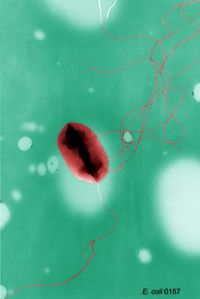EHEC: Difference between revisions
No edit summary |
No edit summary |
||
| Line 17: | Line 17: | ||
|} | |} | ||
==Description== | ==Description== | ||
''Escherichia coli'' O157:H7 is an emerging pathogen that causes hemorrhagic colitis. ''E. coli'' is a Gram negative rod, facultative anaerobe, motile by means of peritrichous flagella, and found in the GI tract of mammals. Most ''E. coli'' are harmless and actually are an important members of a healthy human intestinal microbial community. However, ''E. coli'' is a very diverse group of bacteria consisting of many ecotypes (the harmless variety) and pathotypes. The pathogenic strains of ''E. coli'' can cause diarrheal diseases, urinary tract infections, and even meningitis. The ''E. coli'' pathotypes that cause diarrhea are transmitted via contaminated food or water, or through contact with infected animals or people. ''E. coli'' O157:H7 was first reported by the [[CDC]] in 1982. [[#References|[1]]] | ''Escherichia coli'' O157:H7 is an emerging pathogen that causes hemorrhagic colitis. ''E. coli'' is a Gram negative rod, facultative anaerobe, motile by means of peritrichous flagella, and found in the GI tract of mammals. Most ''E. coli'' are harmless and actually are an important members of a healthy human intestinal microbial community. However, ''E. coli'' is a very diverse group of bacteria consisting of many ecotypes (the harmless variety) and pathotypes. The pathogenic strains of ''E. coli'' can cause diarrheal diseases, urinary tract infections, and even meningitis. The ''E. coli'' pathotypes that cause diarrhea are transmitted via contaminated food or water, or through contact with infected animals or people. ''E. coli'' O157:H7 was first reported by the [[CDC]] in 1982. [[#References|[1]]] ''E. coli'' O157:H7 is one of several pathotypes classified as enterohemorrhagic ''E. coli'' (EHEC). EHEC cause disease by producing a toxin called Shiga toxin, Shiga toxin causes bloody diarrhea and in approximately 5-10% of cases hemolytic uremic syndrome (HUS), which can lead to complete kidney failure. Patients with bloody diarrhea usually recover within a week and those who develop HUS usually recover within a few weeks, but in cases of kidney failure the patient may die. While people of any age are susceptible, the young and elderly are more often affected. Treatment of EHEC typically involves rehydration without administration of antibiotics and hospitalization in severe cases, especially HUS. EHEC infection is prevented by good hygiene, proper cooking of food, not swallowing water while swimming, and avoiding unpasteurized milk or apple cider. | ||
===Pathogenesis=== | ===Pathogenesis=== | ||
Revision as of 21:32, 10 June 2013

Etiology/Bacteriology
Taxonomy
| Domain = Bacteria | Phylum = Proteobacteria | Class = Gammaproteobacteria | Order = Enterobacteriales | Family = Enterobacteriaceae | Genus = Escherichia | species = E. coli | subspecies = O157:H7 | prototype strain = EDL933 |
|
NCBI: Taxonomy Genome: Escherichia coli O157:H7 str. EDL933 |
Description
Escherichia coli O157:H7 is an emerging pathogen that causes hemorrhagic colitis. E. coli is a Gram negative rod, facultative anaerobe, motile by means of peritrichous flagella, and found in the GI tract of mammals. Most E. coli are harmless and actually are an important members of a healthy human intestinal microbial community. However, E. coli is a very diverse group of bacteria consisting of many ecotypes (the harmless variety) and pathotypes. The pathogenic strains of E. coli can cause diarrheal diseases, urinary tract infections, and even meningitis. The E. coli pathotypes that cause diarrhea are transmitted via contaminated food or water, or through contact with infected animals or people. E. coli O157:H7 was first reported by the CDC in 1982. [1] E. coli O157:H7 is one of several pathotypes classified as enterohemorrhagic E. coli (EHEC). EHEC cause disease by producing a toxin called Shiga toxin, Shiga toxin causes bloody diarrhea and in approximately 5-10% of cases hemolytic uremic syndrome (HUS), which can lead to complete kidney failure. Patients with bloody diarrhea usually recover within a week and those who develop HUS usually recover within a few weeks, but in cases of kidney failure the patient may die. While people of any age are susceptible, the young and elderly are more often affected. Treatment of EHEC typically involves rehydration without administration of antibiotics and hospitalization in severe cases, especially HUS. EHEC infection is prevented by good hygiene, proper cooking of food, not swallowing water while swimming, and avoiding unpasteurized milk or apple cider.
Pathogenesis
Clinical features
Diagnosis
Treatment
Prevention
Host Immune Response
References
Created by Tyrrell Conway at the University of Oklahoma.
